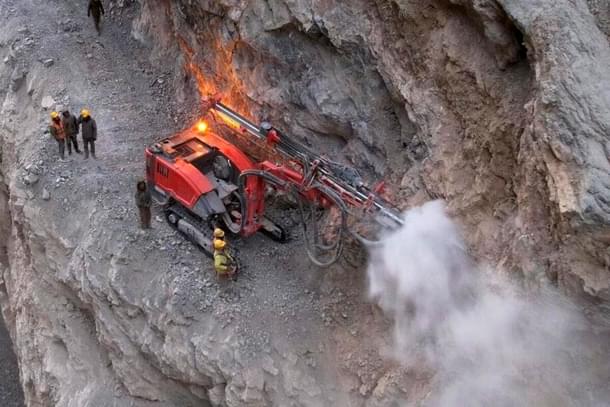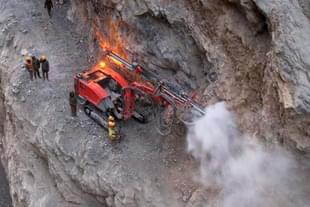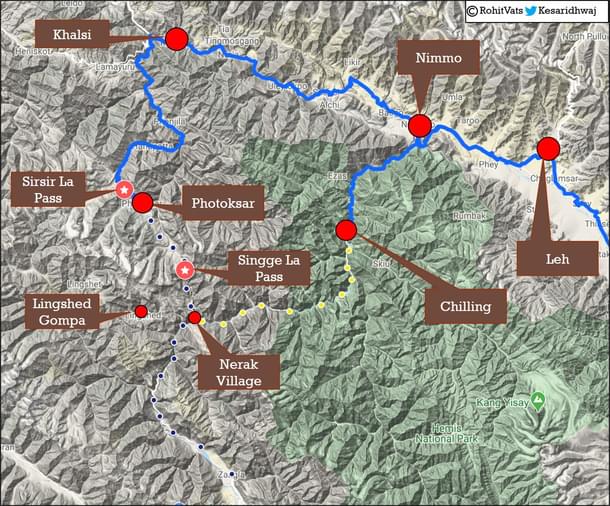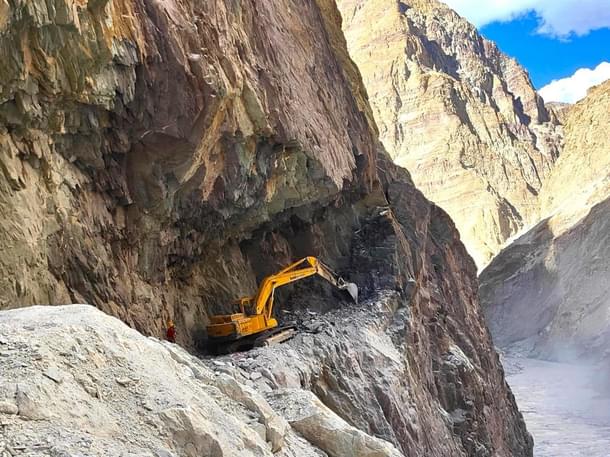Defence
New Road To Ladakh: Chinese Aggression On LAC Hasn't Dampened India's Resolve To Build Border Infrastructure At Feverish Pace
Ujjwal Shrotryia
Mar 27, 2024, 03:35 PM | Updated 03:35 PM IST
Save & read from anywhere!
Bookmark stories for easy access on any device or the Swarajya app.


India has been building new infrastructure in border areas along the frontier with China at an unrelenting pace for the past few years, much of which is now reaching completion.
Last week, the Border Roads Organisation (BRO) finished linking the crucial Nimmu-Padum-Darcha (NPD) road, providing a new and faster way to reach Leh in Ladakh from the rest of India.
This 298-kilometre road creates a third route to Ladakh, which is shorter than the existing two routes available.
The other two routes to Ladakh are the Srinagar-Drass-Kargil NH-1D highway, which goes over the high Zoji-La pass at 11,575 feet, and the treacherous Manali-Sarchu-Leh highway.
These paths are usually blocked for about six months each winter because of heavy snow and avalanches.
The Srinagar-Drass-Kargil route has been the relatively easier way to reach Ladakh, going through Jammu and Kashmir. This route includes crossing the Zoji-La pass at 11,575 feet, which is often closed in winter due to heavy snow and avalanches.
![Map depicting the existing two axis [Sringar-Drass-Kargil-Leh and Manali-Leh route] of connectivity to Leh.
(X/ @KesariDhwaj)](https://swarajya.gumlet.io/swarajya/2024-03/bb21b76f-abad-471b-b6a8-1e1815e0534e/Ee_o5xjUwAAmnTC.jpeg?w=610&q=75&compress=true&format=auto)
Two tunnels, the Z-Morh in Sonmarg and the 14-kilometre-long Zoji-La tunnel, are being built to keep this route open all year.
However, this path runs dangerously close to the Line of Control (LoC) at Drass with Pakistan. Kargil war of 1999 was launched to sever the NH-1D that passes very close to Drass to isolate Leh and Siachen.
At the height of the war, Pakistani forces were within kilometres of this vital artery, highlighting the route's vulnerability in periods of conflict.
On the other hand, the Manali-Leh highway starts in Himachal Pradesh and crosses five major high-altitude passes, viz, the Rohtang Pass (13,058 ft), Baralacha-La pass (15,910 ft), Nakee-La pass (15,547 ft), Lachulung-La pass (16,600 ft), and finally the highest, Tanglang-La pass (17,480 ft).
The Atal tunnel's opening beneath Rohtang Pass in October 2020 offers some relief, yet the average elevation of the other four passes still exceeds 15,000 feet challenging both vehicles and people traversing the route.
The low-oxygen content and bone-chilling cold at these high altitudes make these passes extremely difficult to cross.
The constant threat of avalanches and landslides complicates the situation further.
The new NPD route will ease all these issues.
After crossing Manali through the Atal tunnel, from Darcha the route will enter into the Zanskar valley through the 16,580 ft high Shinku-La/Shingo-La pass till Padum.
This route was only thrown open to civilains and 4x4 vehicles in 2019.
There are plans to construct a 4-kilometre-long tunnel under the Shinku-La pass, which will make the route all-weather. The construction of the tunnel is expected to start sometime in the middle of 2024 with a deadline for completion in 2026.
From Padum, the route will pass through the Nerak and Chilling villages, finally reaching Nimmu that has direct highway connectivity to Leh.

The six kilometres long Nimmu-Chilling section of the route was the remaining part whose breakthrough was achieved by BRO on Holi (25 March).
The construction of this stretch involved cutting through sheer walls of hard rock with an incline of 80 to 85 degrees.
This will save five-to-six hours when travelling from Manali to Leh. This will not only provide connectivity to locals in the form of Manali who were, until now, dependent on Kargil for supplies in the winter months but also spur tourism leading to development in the region.

The third axis of connectivity to Leh, provided by the NPD route, holds strategic importance for the Indian Army, especially considering the ongoing four-year standoff with Chinese forces in Ladakh.
This additional route ensures a more reliable and faster supply chain for troops stationed in the region's remote areas.
In the face of heightened tensions and the need for rapid deployment and re-supply of military assets, the NPD route offers a critical alternative to the existing paths, which are susceptible to natural blockades and proximity to adversarial lines.
The enhanced accessibility and reduced travel time significantly bolster the army's operational readiness and flexibility, ensuring that soldiers have the necessary support and resources to maintain a strong defensive posture in Ladakh.
China's persistent aggression along the LAC over the last four years hasn't slowed India's relentless push to develop infrastructure at a feverish pace.
Staff Writer at Swarajya. Writes on Indian Military and Defence.





